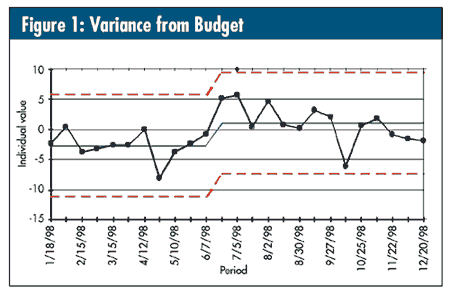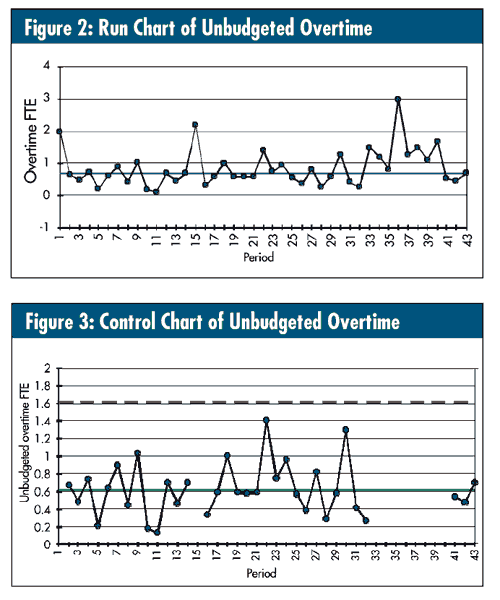2007 Resolutions: Weight and… Budget? (Pt. 2)
Remember the two graphs from my January column (“2007 Resolutions: Weight and… Budget? [Pt. 1]”)? My friend’s spending was stable, but the comparison to budget wasn’t (a special cause of eight-in-a-row above the median). How could that be? Well, there was a process change, of sorts: She’d consistently been coming in below budget, so they changed her budget! Because that’s arbitrary, could someone explain to me how that should change the process she’s currently perfectly designed to get?
 It becomes even more dramatic when one does a control chart of the variance, as seen in figure 1. It becomes even more dramatic when one does a control chart of the variance, as seen in figure 1.
As seen from the average of her process, since the budget change, she’s currently perfectly designed to settle approximately one full-time equivalent (FTE) above budget. Yet, her variance as calculated every two weeks will be in the range of -7 to 9, and one period can differ from its predecessor by as much as 10.1. The process has spoken. The biweekly meetings looking at the current performance are a waste of time, and she will come in over budget. If the new budget is so important, why don’t they do a matrix analysis (as seen in my October 2005 column, “A Common-Cause Strategy for Count Data”) of where the current aggregated dollars go?
At the same organization, I had another friend who used to get routinely beaten up because of her unbudgeted overtime. She gave me 42 unwieldy biweekly tabular reports, from which I took this number from the last page and plotted the run chart seen in figure 2.
The peaks correspond to periods with Monday holidays. So, she was already over budget right from the start! As her year-to-date figure inevitably improved, Memorial Day weekend hit… and then the 4th of July… and then Labor Day….
She’s perfectly designed to have excessive overtime during a period with a Monday holiday. For now, these should be plotted and dealt with separately.
Then there’s the period of eight-in-a-row toward the end. I asked her what went on during this period. She had two receptionists quit, and replacements were hired at the end. This person was a very good manager. If employee turnover had been a consistent process problem, there would be no such signal, the average would be higher and the variation would be wider.
Eliminating these special causes resulted in the control chart seen in figure 3.

She’s perfectly designed to have 0.63 FTE overtime routinely--even though she’s not supposed to. From the lower limit, there will eventually be a pay period where she doesn’t have any overtime, and she’ll be told, “Well, you did it that month, so do it every month.” Might a matrix analysis of where the overtime budget dollars go--for all of these stable periods aggregated together--be useful?
You can continue to go to your silly budget performance meeting. I still have good intentions about my New Year’s resolution to lose weight, too.
Davis Balestracci is a member of the American Society for Quality and past chair of its statistics division. He is also a dynamic speaker with unique and entertaining insights into the places where process, statistics and quality meet. Visit his Web site at www.dbharmony.com .
|